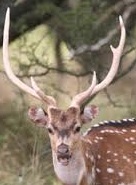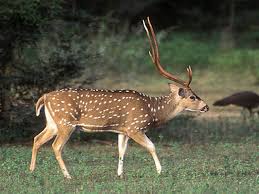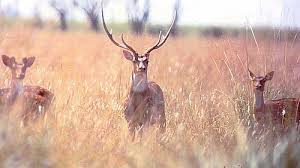The chital or cheetal, also known as spotted deer or axis deer, is a deer found in the Indian subcontinent.
The species was first described by German naturalist Johann Christian Polycarp Erxleben in 1777. A moderately
sized deer, male chital reach nearly 90 centimetres (35 in) and females 70 centimetres (28 in) at the
shoulder. While males weigh 30-75 kilograms (66-165 lb), the lighter females weigh 25-45 kilograms (55-99 lb).
The species is sexually dimorphic: males are larger than females, and antlers are present only on males. The
upper parts are golden to rufous, completely covered in white spots. The abdomen, rump, throat, insides of
legs, ears and tail are all white. The antlers, three-pronged, are nearly 1 metre (3.3 ft) long.
Description
The chital is a moderately sized deer. Males reach nearly 90 centimetres (35 in) and females 70 centimetres
(28 in) at the shoulder; the head-and-body length is around 1.7 metres (5.6 ft). While males weigh 30-75
kilograms (66-165 lb), the lighter females weigh 25-45 kilograms (55-99 lb). Exceptionally large males can
weigh up to 98 to 110 kg (216 to 243 lb). The tail, 20 centimetres (7.9 in) long, is marked by a dark stripe
that stretches along its length. The species is sexually dimorphic: males are larger than females, and
antlers are present only on males.
The dorsal (upper) parts are golden to rufous, completely covered in white spots. The abdomen, rump, throat,
insides of legs, ears and tail are all white. A conspicuous black stripe runs along the spine (back bone).
Chital have well-developed preorbital glands (near the eyes) which have stiff hairs. They also have
well-developed metatarsal glands and pedal glands located in their hind legs. The preorbital glands, larger
in males than in females, are frequently opened in response to certain stimuli.
Either of the antlers has three lines on it. The brow tine (the first division in the antler) is roughly
perpendicular to the beam (the central stalk of the antler).[4] The antlers, three-pronged, are nearly 1
metre (3.3 ft) long. Antlers, as in most other cervids, are shed annually. The antlers emerge as soft
tissues (known as velvet antlers) and progressively harden into bony structures (known as hard antlers),
following mineralisation and blockage of blood vessels in the tissue, from the tip to the base. A study of
the mineral composition of the antlers of captive barasinga, chital and hog deer showed that the horns of
the deer are very similar. The mineral content of the chital's horns was determined to be (in milligram and
ounce per kilogram): 6.1 milligrams (0.00022 oz) copper, 8.04 milligrams (0.000284 oz) cobalt and 32.14
milligrams (0.001134 oz) zinc.
Hooves measure between 4.1 and 6.1 centimetres (1.6 and 2.4 in) in length; hooves of the forelegs are longer
than those of the hind legs. The toes taper to a point. The milk canine, nearly 1 centimetre (0.39 in) long,
falls off before one year of age, but is not replaced by a permanent tooth as in other cervids.
Compared to the hog deer, the chital has a more cursorial build. The antlers and brow tines are longer than
those in the hog deer. The pedicles (the bony cores from which antlers arise) are shorter and the auditory
bullae are smaller in the chital. The chital may be confused with the fallow deer. The chital is darker and
has several white spots, whereas the fallow deer has white splotches. The chital has a prominent white patch
on its throat, while the throat of the fallow deer is completely white. The hairs are smooth and flexible.
Behavior
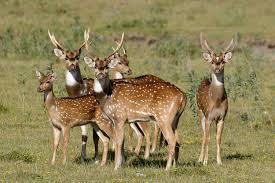
Chital are active throughout the day. In the summer, time is spent in rest under shade and the sun's glare is
avoided if the temperature reaches 80 °F (27 °C); activity peaks as dusk approaches. As days grow cooler,
foraging begins before sunrise and peaks by early morning. Activity slows down during midday, when the
animals rest or loiter about slowly. Foraging recommences by late afternoon and continues till midnight. They
fall asleep a few hours before sunrise, typically in the forest which is cooler than the glades. These deer
typically move in a single file on specific tracks, with a distance of two to three times their width between
them, when on a journey, typically in search of food and water sources. A study in the Gir National Park
(Gujarat, India) showed that chital travel the most in summer of all seasons. When cautiously inspecting its
vicinity, the chital will stand motionless and hear with rapt attention, facing the potential danger if any.
This stance may be adopted by nearby individuals as well. As an anti-predator measure, chital will flee in
groups (unlike the hog deer that disperse on alarm); sprints are often followed by hiding in dense
undergrowth. The running chital has its tail raised, exposing the white underparts. The chital can leap and
clear fences as high as 1.5 metres (4.9 ft), but prefers to dive under them. It stays within 300 metres
(980 ft) of cover.
A gregarious animal, the chital forms matriarchal herds comprising an adult female and her offspring of the
previous and the present year, which may be associated with individuals of any age and either sex, male
herds and herds of juveniles and mothers. Small herds are common, though aggregations of as many as 100
individuals have been observed. Groups are loose and disband frequently, save for the juvenile-mother herd.
Herd membership in Texas is typically up to 15; herds can have five to 40 members in India. Studies in the
Nallamala Hills (Andhra Pradesh, India) and the Western Ghats (western coast of India) showed seasonal
variation in the sex ratio of herds; this was attributed to the tendency of females to isolate themselves
ahead of parturition. Similarly, rutting males leave their herds during the mating season, hence altering the
herd composition. Large herds were most common in monsoon, observed foraging in the grasslands. Predators of
the chital include wolves, Bengal tigers, Asiatic lions, leopards, Indian rock pythons, dholes, Indian pariah
dogs and mugger crocodiles. Red foxes and golden jackals target juveniles. Males are less vulnerable than
females and juveniles.
A vocal animal, the chital, akin to the North American elk, gives out bellows and alarm barks. Its calls are,
however, not as strong as those of elk or red deer; they are mainly coarse bellows or loud growls. Bellowing
coincides with rutting. Dominant males guarding females in oestrus make high-pitched growls at less powerful
males. Males may moan during aggressive displays or while resting. The chital, mainly females and juveniles,
will bark persistently when alarmed or if they encounter a predator. Fawns in search of their mother often
squeal. The chital can respond to the alarm calls of several animals such as the common myna and langurs.
Marking behaviour is pronounced in males. Males have well-developed preorbital glands (near the eyes). They
stand on their hindlegs to reach tall branches and rub the open preorbital glands to deposit their scent
there. This posture is also used while foraging. Urine-marking is also observed; the smell of urine is
typically stronger than that of the deposited scent. Sparring between males begins with the larger male
displaying his dominance before the other-this display consists of hissing heading away from the other male
with the tail facing him, the nose pointing to the ground, the ears down, the antlers upright and the upper
lip raised. The fur often bristles during the display. The male approaches the other in a slow gait. Males
with velvet antlers may hunch over instead of standing erect as the males with hard antlers. The opponents
then interlock their horns and push against each other, with the smaller male producing a sound at times
which is louder than that produced by sambar deer but not as much as the barasinga's. The fight terminates
with the males stepping backward, or simply leaving and foraging. Fights are not generally serious.
Individuals may occasionally bite one another.
Common myna are often attracted to the chital. An interesting relationship has been observed between herds
of chital and troops of the northern plains gray langurs, a widespread South Asian monkey. Chital benefit
from the langurs' eyesight and ability to post a lookout from trees, while the langur benefit from the
chital's strong sense of smell-both of which help keep a check on potential danger. The chital also benefit
from fruits dropped by langurs from trees such as Terminalia bellerica and Phyllanthus emblica. The chital
has been observed foraging with sambar deer in the Western Ghats.
Diet
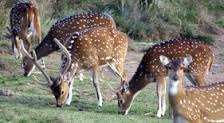
Grazers as well as browsers, the chital mainly feed on grasses throughout the year. They prefer young shoots,
in the absence of whose tall and coarse grasses will be nibbled off at the tips. Browse forms a major portion
of the diet only in the winter months-October to January-when the grasses, tall or dried up, are no more
palatable. Browse includes herbs, shrubs, foliage, fruits and forbs; Moghania species are often preferred
while browsing. Fruits eaten by chital in the Kanha National Park (Madhya Pradesh, India) include those of
Ficus species from January to May, Cordia myxa from May to June, Syzygium cumini from June to July.
Individuals tend to group together and forage while moving slowly. Chital are generally silent when grazing
together. Males often stand on their hindlegs to reach tall branches. Water holes are visited nearly twice
daily, with great caution. In the Kanha National Park, mineral licks rich in calcium and phosphorus pentoxide
were scraped at by the incisors. Chital in the Sunderbans may be omnivores; remains of red crabs have been
found in the rumen of individuals.
Reproduction
Sexual maturity is reached within Breeding takes place throughout the year, with peaks that vary
geographically. Sperms are produced year-round, though testosterone levels register a fall during the
development of the antlers. Females have regular oestrus cycles, each lasting three weeks. The female can
conceive again two weeks to four months after the birth. Males sporting hard antlers are dominant over
those in velvet or those without antlers, irrespective of their size. Courtship is based on tending bonds.
A rutting male fasts during the mating season and follow and guard a female in oestrus. The pair will do
several bouts of chasing and mutual licking before copulation.
The newborn is hidden for a week after birth, a period much shorter than most other deer. The mother-fawn
bond is not very strong, as the two get separated often, though they can reunite easily as the herds are
cohesive. If the fawn dies, the mother can breed once again so as to give birth twice that year. The males
continue their growth till seven to eight years. The average lifespan in captivity is nearly 22 years. The
longevity in the wild, however, is merely five to ten years.
The chital is found in large numbers in dense deciduous or semievergreen forests and open grasslands. The
highest numbers of chital are found in the forests of India, where they feed upon tall grass and shrubs.
Chital have been also spotted in Phibsoo Wildlife Sanctuary in Bhutan, which has the only remaining natural
sal (Shorea robusta) forest in the country. They do not occur at high altitudes, where they are usually
replaced by other species such as the sambar deer. They also prefer heavy forest cover for shade and avoid
direct sunlight.
Habitat and distribution
The chital ranges over 8-30ºN in India and through Nepal, Bhutan, Bangladesh, and Sri Lanka. The western
limit of its range is eastern Rajasthan and Gujarat. The northern limit is along the Bhabar-terai belt
of the foothills of the Himalaya and from Uttar Pradesh and Uttaranchal through to Nepal, northern West
Bengal and Sikkim and then to western Assam and the forested valleys of Bhutan which are below 1,100 m
asl. The eastern limit of its range is through western Assam to the Sunderbans of West Bengal (India) and
Bangladesh. Sri Lanka is the southern limit. Chital occur sporadically in the forested areas throughout the
rest of the Indian peninsula. Within Bangladesh, it currently only exists in the Sundarbans and some
Eco-parks situated around the Bay of Bengal, as it became extinct in the central and north-east of the
country.



